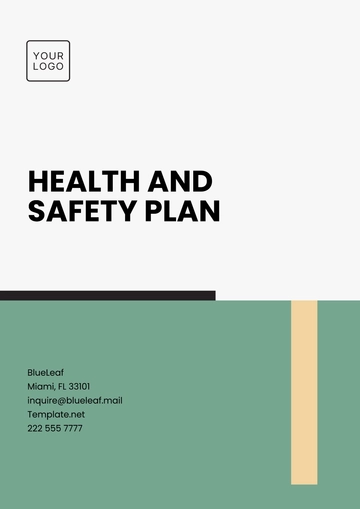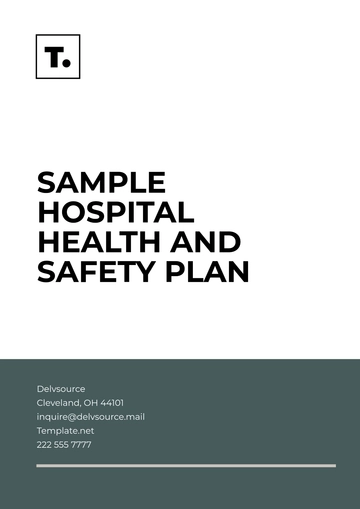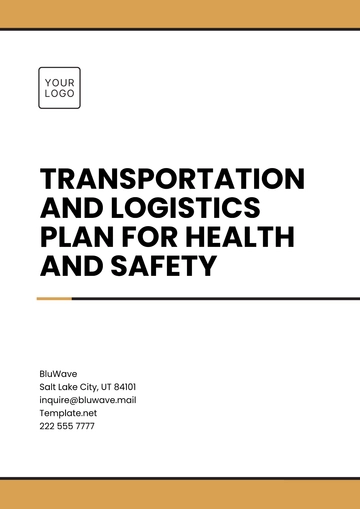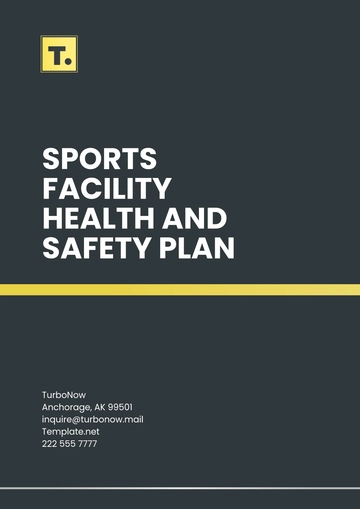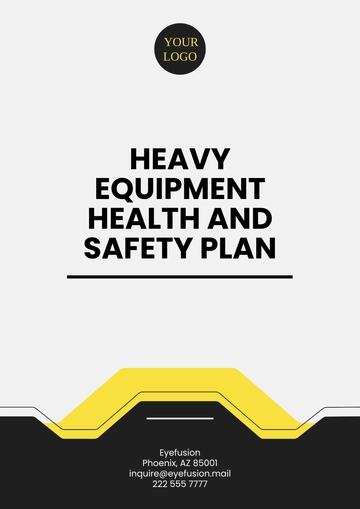Free Health & Safety Training Plan

I. Introduction
At [Your Company Name], the health and safety of our employees is our top priority. We recognize that a safe working environment is essential for the well-being of our team and the overall success of our operations. This Health & Safety Training Plan is designed to equip all employees with the necessary knowledge and skills to identify potential hazards, follow safety protocols, and respond effectively to emergencies. By implementing this plan, [Your Company Name] aims to foster a culture of safety where every team member is proactive in preventing accidents and ensuring a secure workplace.
This training plan is aligned with the latest Occupational Safety and Health Administration (OSHA) standards and other relevant US regulations. It is tailored to address the specific risks associated with our industry and operations. All employees, from new hires to seasoned staff, will undergo comprehensive training that covers a wide range of topics, including workplace ergonomics, emergency procedures, and the proper use of personal protective equipment (PPE). By adhering to this plan, [Your Company Name] not only complies with legal requirements but also demonstrates our commitment to maintaining a safe and healthy work environment for everyone.
II. Objectives
The Health & Safety Training Plan at [Your Company Name] is designed to establish a solid foundation for maintaining a secure and hazard-free workplace. This section outlines the key objectives that will guide our training efforts, ensuring that every employee is equipped with the knowledge and tools necessary to contribute to a safe work environment. The following objectives are central to our commitment to health and safety:
To understand common workplace hazards
To learn emergency response procedures
To promote a culture of safety
To ensure compliance with health and safety regulations
III. Training Schedule
To ensure that all employees at [Your Company Name] are thoroughly trained in health and safety practices, we have developed a structured training schedule that spans four weeks. Each week focuses on a specific aspect of workplace safety, progressively building the knowledge and skills needed to maintain a safe working environment. This schedule is designed to be both comprehensive and manageable, allowing participants to absorb and apply the information effectively. Below is the training schedule, including the topics covered each week and the designated instructor for each session:
Week | Topic | Instructor |
|---|---|---|
1 | Introduction to Workplace Safety | [Name] |
2 | Hazard Identification and Control | [Name] |
3 | Emergency Response Procedures | [Name] |
4 | Safe Work Practices | [Name] |
By following this training schedule, [Your Company Name] ensures that all employees receive the necessary instruction and guidance to uphold a safe and healthy work environment. Each session is carefully designed to build on the previous week's learning, culminating in a comprehensive understanding of workplace safety. Through consistent training and expert instruction, we aim to empower our team to proactively identify risks and respond effectively to any safety challenges.
IV. Module Descriptions
Understanding the specific content of each training module is crucial for effective learning and application. At [Your Company Name], we have designed each module to address key areas of workplace safety that are essential for creating and maintaining a safe work environment. These modules are tailored to provide both foundational knowledge and practical skills, ensuring that every employee is well-prepared to handle safety-related tasks and challenges.
The table below outlines the core modules included in our Health & Safety Training Plan. Each module is briefly described, highlighting the primary focus and learning outcomes. This structured approach allows participants to grasp the significance of each topic and understand how it contributes to overall workplace safety.
Module | Description |
|---|---|
Introduction to Workplace Safety | Covers the basics of workplace safety, emphasizing the importance of safety protocols and common hazards. |
Hazard Identification and Control | Focuses on identifying potential hazards and implementing control measures to reduce risk. |
Emergency Response Procedures | Provides training on responding to emergencies, including fire, medical situations, and evacuations. |
Safe Work Practices | Educates employees on safe practices, including proper PPE use and safe operation of equipment. |
V. Evaluation and Assessment
Ensuring the effectiveness of our Health & Safety Training Plan requires a thorough evaluation and assessment process. This section outlines the methods used to evaluate the knowledge and skills acquired by employees during the training. The goal is to confirm that all participants have a comprehensive understanding of workplace safety and can apply this knowledge in real-world scenarios. The assessment process is divided into several key components, each designed to measure different aspects of the training outcomes.
1. Knowledge Tests
Throughout the training program, participants will be required to complete knowledge tests that cover the material presented in each module. These tests are designed to assess the employees’ understanding of key concepts, such as hazard identification, emergency response procedures, and safe work practices. By evaluating knowledge retention at regular intervals, [Your Company Name] can identify areas where additional training may be needed and ensure that all employees meet the required safety standards.
2. Practical Demonstrations
In addition to knowledge tests, employees will be asked to participate in practical demonstrations. These hands-on assessments will allow participants to showcase their ability to apply safety protocols in simulated scenarios. For example, employees may be required to demonstrate the correct use of personal protective equipment (PPE), perform a mock emergency evacuation, or identify potential hazards in a controlled environment. These practical exercises are crucial for reinforcing the training material and ensuring that employees are prepared to act safely and effectively in their daily tasks.
3. Feedback and Continuous Improvement
Feedback from participants is an essential part of the evaluation process. After each training session, employees will have the opportunity to provide feedback on the content, delivery, and relevance of the material. This feedback will be used to continuously improve the training program, making adjustments as necessary to address any gaps or emerging safety concerns. Additionally, follow-up assessments will be conducted periodically to ensure that the training has a lasting impact and that employees continue to adhere to safety protocols over time.
4. Certification and Compliance
Upon successful completion of the training program, employees will receive a certification indicating their compliance with [Your Company Name]’s health and safety standards. This certification process not only recognizes the employee’s efforts but also ensures that [Your Company Name] meets legal requirements for workplace safety training.
The Health & Safety Training Plan at [Your Company Name] is more than just a compliance requirement—it is a commitment to fostering a safe, secure, and healthy work environment for all employees. By thoroughly equipping our team with the necessary knowledge and practical skills, we aim to prevent accidents, respond effectively to emergencies, and promote a culture of safety throughout the organization. As we implement this plan, we encourage all employees to actively participate, ask questions, and provide feedback, ensuring that our safety practices evolve to meet the highest standards. Together, we can create a workplace where safety is not just a priority but a shared responsibility embraced by every member of [Your Company Name].
- 100% Customizable, free editor
- Access 1 Million+ Templates, photo’s & graphics
- Download or share as a template
- Click and replace photos, graphics, text, backgrounds
- Resize, crop, AI write & more
- Access advanced editor
Ensure effective training with Template.net's Health & Safety Training Plan Template. Fully editable and customizable, this template allows you to outline detailed safety training programs. Tailor each section to your organization’s needs, editable in our Ai Editor Tool, for a professional and comprehensive training plan that enhances workplace safety.
You may also like
- Finance Plan
- Construction Plan
- Sales Plan
- Development Plan
- Career Plan
- Budget Plan
- HR Plan
- Education Plan
- Transition Plan
- Work Plan
- Training Plan
- Communication Plan
- Operation Plan
- Health And Safety Plan
- Strategy Plan
- Professional Development Plan
- Advertising Plan
- Risk Management Plan
- Restaurant Plan
- School Plan
- Nursing Home Patient Care Plan
- Nursing Care Plan
- Plan Event
- Startup Plan
- Social Media Plan
- Staffing Plan
- Annual Plan
- Content Plan
- Payment Plan
- Implementation Plan
- Hotel Plan
- Workout Plan
- Accounting Plan
- Campaign Plan
- Essay Plan
- 30 60 90 Day Plan
- Research Plan
- Recruitment Plan
- 90 Day Plan
- Quarterly Plan
- Emergency Plan
- 5 Year Plan
- Gym Plan
- Personal Plan
- IT and Software Plan
- Treatment Plan
- Real Estate Plan
- Law Firm Plan
- Healthcare Plan
- Improvement Plan
- Media Plan
- 5 Year Business Plan
- Learning Plan
- Marketing Campaign Plan
- Travel Agency Plan
- Cleaning Services Plan
- Interior Design Plan
- Performance Plan
- PR Plan
- Birth Plan
- Life Plan
- SEO Plan
- Disaster Recovery Plan
- Continuity Plan
- Launch Plan
- Legal Plan
- Behavior Plan
- Performance Improvement Plan
- Salon Plan
- Security Plan
- Security Management Plan
- Employee Development Plan
- Quality Plan
- Service Improvement Plan
- Growth Plan
- Incident Response Plan
- Basketball Plan
- Emergency Action Plan
- Product Launch Plan
- Spa Plan
- Employee Training Plan
- Data Analysis Plan
- Employee Action Plan
- Territory Plan
- Audit Plan
- Classroom Plan
- Activity Plan
- Parenting Plan
- Care Plan
- Project Execution Plan
- Exercise Plan
- Internship Plan
- Software Development Plan
- Continuous Improvement Plan
- Leave Plan
- 90 Day Sales Plan
- Advertising Agency Plan
- Employee Transition Plan
- Smart Action Plan
- Workplace Safety Plan
- Behavior Change Plan
- Contingency Plan
- Continuity of Operations Plan
- Health Plan
- Quality Control Plan
- Self Plan
- Sports Development Plan
- Change Management Plan
- Ecommerce Plan
- Personal Financial Plan
- Process Improvement Plan
- 30-60-90 Day Sales Plan
- Crisis Management Plan
- Engagement Plan
- Execution Plan
- Pandemic Plan
- Quality Assurance Plan
- Service Continuity Plan
- Agile Project Plan
- Fundraising Plan
- Job Transition Plan
- Asset Maintenance Plan
- Maintenance Plan
- Software Test Plan
- Staff Training and Development Plan
- 3 Year Plan
- Brand Activation Plan
- Release Plan
- Resource Plan
- Risk Mitigation Plan
- Teacher Plan
- 30 60 90 Day Plan for New Manager
- Food Safety Plan
- Food Truck Plan
- Hiring Plan
- Quality Management Plan
- Wellness Plan
- Behavior Intervention Plan
- Bonus Plan
- Investment Plan
- Maternity Leave Plan
- Pandemic Response Plan
- Succession Planning
- Coaching Plan
- Configuration Management Plan
- Remote Work Plan
- Self Care Plan
- Teaching Plan
- 100-Day Plan
- HACCP Plan
- Student Plan
- Sustainability Plan
- 30 60 90 Day Plan for Interview
- Access Plan
- Site Specific Safety Plan
